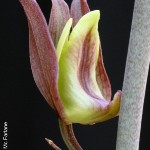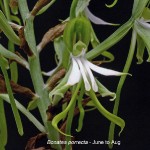Two more early flowering Eulophias and the only winter flowering orchid
In my first article, I dealt with three of the earliest flowering orchids, all Eulophias. In this article, I will cover a further 2 early flowering Eulophias and for the first time, a Bonatea. The Eulophias hereroensis is distinctive due to having 3 erect sepals resembling rabbit ears. The Eulophias streptopetala has pseudobulbs that are partially above the ground (similar to a Cymbidium) and large pleated leaves. The Bonatea porrecta is unique in that it flowers from late in June, when the leaves have already withered. As before, all are terrestrial orchids (grow in the ground).
Eulophia hereoensis
This is a distinctive species which is not similar to any others, by way of it's dry growing conditions and 3 erect sepals resembling rabbit ears. The plant is fairly slender and can reach a height of just over half a meter. The leaves are partially to fully developed at flowering time and the pseudobulbs sometimes are partially above the ground. Flowers can be between 5 and 25 and are yellow to greenish yellow, with veined sepals that are striped in a reddish brown to maroon colour. The petals lie forward and the spur is 3 – 4mm long.
Eulophia streptopetala
This robust terrestrial can reach close to 2m (although I have seen a flower spike of nearer to 2,5m) and has pseudobulbs that are partially above the ground, much like a cymbidium. The leaves are fairly wide and pleated. Between 10 and 40 flowers have olive-yellow to green sepals suffused with reddish to chocolate brown. Petals are yellow on the outside and cream on the inside and project forwards. The spur is a short 2mm.
Bonatea porrecta
This species is different to all others in our area in that flowering commences between late June when the leaves have withered, due to the dry and cold weather. The plant starts growing after the early summer rains and continues until late autumn, when it is in full leaf and commences the start of the terminal inflorescence.
Credits and refrences
Article and photographs by Duncan Mc Farlane
Proof-read and edited by Karsten Wodrich


